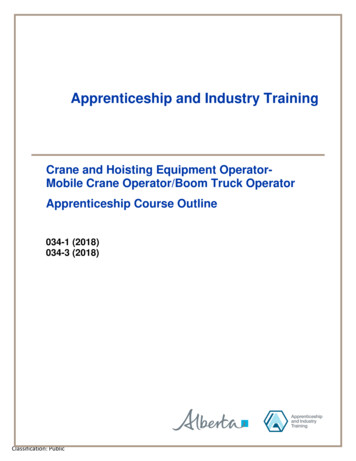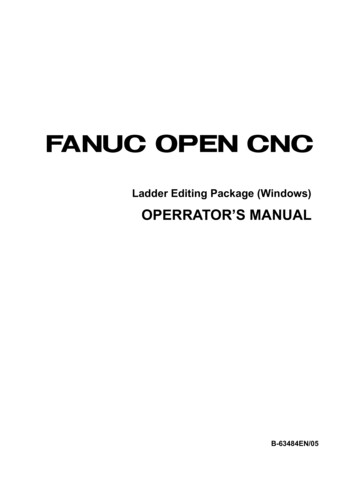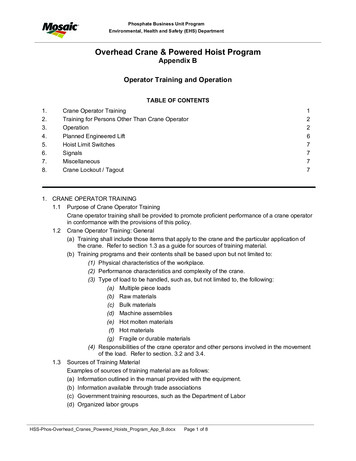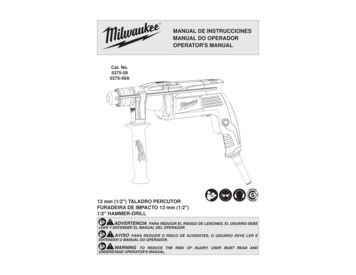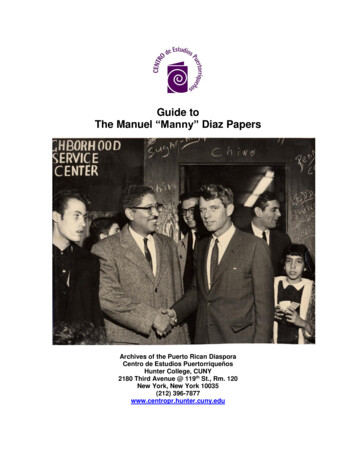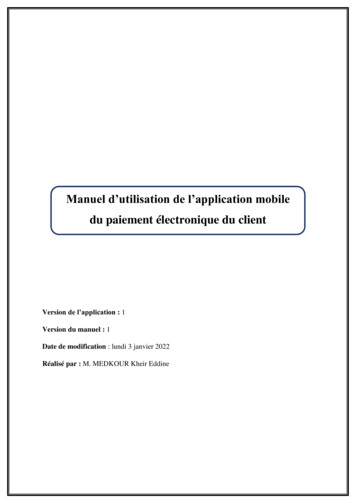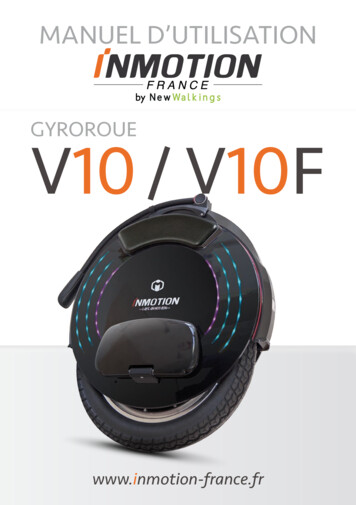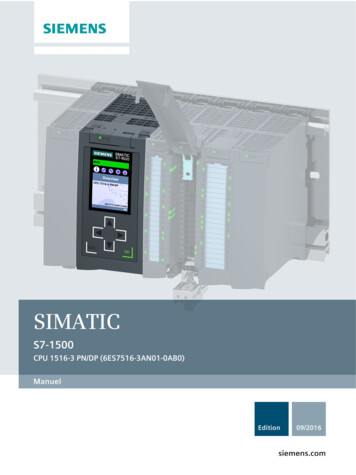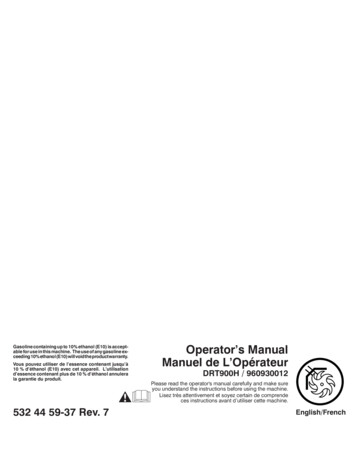
Transcription
Gasoline containing up to 10% ethanol (E10) is acceptable for use in this machine. The use of any gasoline exceeding 10% ethanol (E10) will void the product warranty.Vous pouvez utiliser de l’essence contenant jusqu’à10 % d’éthanol (E10) avec cet appareil. L’utilisationd’essence contenant plus de 10 % d’éthanol annulerala garantie du produit.532 44 59-37 Rev. 7Operator’s ManualManuel de L’OpérateurDRT900H / 960930012Please read the operator's manual carefully and make sureyou understand the instructions before using the machine.Lisez très attentivement et soyez certain de comprendeces instructions avant d’utiliser cette machine.English/French
SAFETY RULESSafe Operation Practices for Walk-Behind Powered Rotary TillersTRAINING Read the Manual carefully. Be thoroughly familiar withthe controls and the proper use of the equipment.Know how to stop the unit and disengage the controlsquickly.Never allow children to operate the equipment. Neverallow adults to operate the equipment without properinstruction.Keep the area of operation clear of all persons, particularly small children, and pets. PREPARATION Thoroughly inspect the area where the equipment isto be used and remove all foreign objects.Disengage all clutches and shift into neutral beforestarting the engine (motor).Do not operate the equipment without wearing adequate outer garments. Wear footwear that will improvefooting on slippery surfaces.Handle fuel with care; it is highly flammable.Use an approved fuel container.Never add fuel to a running engine or hot engine.Fill fuel tank outdoors with extreme care. Never fill fueltank indoors.Replace gasoline cap securely and clean up spilledfuel before restarting.Use extension cords and receptacles as specified bythe manufacturer for all units with electric drive motorsor electric starting motors.Never attempt to make any adjustments while theengine (motor) is running (except where specificallyrecommended by manufacturer).MAINTENANCE AND STORAGE Keep machine, attachments, and accessories in safeworking condition.Check shear pins, engine mounting bolts, and otherbolts at frequent intervals for proper tightness to besure the equipment is in safe working condition.Never store the machine with fuel in the fuel tank insidea building where ignition sources are present, suchas hot water and space heaters, clothes dryers, andthe like. Allow the engine to cool before storing in anyenclosure.Always refer to the operator’s guide instructions forimportant details if the tiller is to be stored for an extended period.- IMPORTANT CAUTIONS, IMPORTANTS, AND NOTES ARE A MEANS OFATTRACTING ATTENTION TO IMPORTANT OR CRITICALINFORMATION IN THIS MANUAL.IMPORTANT: USED TO ALERT YOU THAT THERE IS APOSSIBILITY OF DAMAGING THIS EQUIPMENT.OPERATION Never operate the tiller without proper guards, plates,or other safety protective devices in place.Keep children and pets away.Do not overload the machine capacity by attemptingto till too deep at too fast a rate.Never operate the machine at high speeds on slipperysurfaces. Look behind and use care when backing.Never allow bystanders near the unit.Use only attachments and accessories approved bythe manufacturer of the tiller.Never operate the tiller without good visibility or light.Be careful when tilling in hard ground. The tines maycatch in the ground and propel the tiller forward. If thisoccurs, let go of the handlebars and do not restrainthe machine.Do not put hands or feet near or under rotating parts.Exercise extreme caution when operating on or crossing gravel drives, walks, or roads. Stay alert for hiddenhazards or traffic. Do not carry passengers.After striking a foreign object, stop the engine (motor),remove the wire from the spark plug, thoroughly inspectthe tiller for any damage, and repair the damage beforerestarting and operating the tiller.Exercise caution to avoid slipping or falling.If the unit should start to vibrate abnormally, stop theengine (motor) and check immediately for the cause.Vibration is generally a warning of trouble.Stop the engine (motor) when leaving the operatingposition.Take all possible precautions when leaving the machineunattended. Disengage the tines, shift into neutral,and stop the engine.Before cleaning, repairing, or inspecting, shut offthe engine and make certain all moving parts havestopped. Disconnect the spark plug wire, and keep thewire away from the plug to prevent accidental starting.Disconnect the cord on electric motors.Do not run the engine indoors; exhaust fumes aredangerous.NOTE: Gives essential information that will aid you tobetter understand, incorporate, or execute a particularset of instructions.Look for this symbol to point out important safety precautions. It meansCAUTION!!! BECOME ALERT!!! YOURSAFETY IS INVOLVED.CAUTION: Always disconnect sparkplug wire and place wire where it cannot contact spark plug in order to prevent accidental starting when settingup, transporting, adjusting or makingrepairs.WARNINGThe engine exhaust from this product containschemicals known to the State of California tocause cancer, birth defects, or other reproductive harm.2
PRODUCT SPECIFICATIONSGasoline Capacity:2 Quarts (1,89L)Unleaded RegularOil (API:SJ-SN):(Capacity: 18.6 oz. / 0.55L)SAE 30 (Above 40 F / 4 C)SAE 5W30 / 10W30Spark Plug :NGK BPR6ES(Gap: .030" / 0.76mm)CUSTOMER RESPONSIBILITIES Read and observe the safety rules.Follow a regular schedule in maintaining, caring forand using your tiller.Follow instructions under “Maintenance” and “Storage”sections of this Manual.WARNING:This unit is equipped with an internal combustion engine and should not be used on or near any unimproved forest-covered, brush-covered or grass coveredland unless the engine’s exhaust system is equipped witha spark arrester meeting applicable local or state laws (ifany). If a spark arrester is used, it should be maintainedin effective working order by the operator.In the state of California the above is required by law(Section 4442 of the California Public Resources Code).Other states may have similar laws. Federal laws applyon federal lands. See your nearest authorized ServiceCenter/Department for spark arrester.CONGRATULATIONS on your purchase of a new tiller.It has been designed, engineered and manufactured togive you the best possible dependability and performance.Should you experience any problems you cannot easilyremedy, please contact your nearest authorized servicecenter. We have competent, well-trained technicians andthe proper tools to service or repair this unit.Please read and retain this manual. The instructions willenable you to assemble and maintain your tiller properly.Always observe the “SAFETY RULES”.SUPPORT / HELPIf you require assistance or have questions concerning theapplication, operation, maintenance or parts for your product: Visit our website: www.husqvarna.comCall Us Toll Free: 1-800-487-5951TABLE OF CONTENTSSAFETY RULES .2PRODUCT SPECIFICATIONS .3CUSTOMER RESPONSIBILITIES .3ASSEMBLY .4-6OPERATION .7-11MAINTENANCE SCHEDULE .12MAINTENANCE .12-14SERVICE AND ADJUSTMENTS .15-17STORAGE .18TROUBLESHOOTING .19FRANÇAIS.213
ASSEMBLYYour new tiller has been assembled at the factory with exception of those parts left unassembled for shipping purposes.To ensure safe and proper operation of your tiller all parts and hardware you assemble must be tightened securely. Usethe correct tools as necessary to insure proper tightness.TOOLS REQUIRED FOR ASSEMBLYFRONTA socket wrench set will make assembly easier. Standardwrench sizes are listed.(1) Utility knife(1) Tire pressure gauge(1) Pair of pliers(1) 9/16" wrenchLEFTRIGHTOPERATOR’S POSITION (See Fig. 1)When right or left hand is mentioned in this manual, itmeans when you are in the operating position (standingbehind tiller handles).OPERATOR’SPOSITIONFig. 1CONTENTS OF HARDWARE PACK(1) Carriage Bolt3/8-16 UNC x 1 Grade 5(2) Handle Locks(1) Flat Washer 13/32 x 1 x 11 Gauge(1) Center Locknut3/8-16 UNC(1) Handle Lock Lever(1) Pivot Bolt3/8-16 UNC Grade 5Extra Shear Pins & Clips4(1) Hairpin Clip
ASSEMBLYUNPACKING CARTON (See Fig. 2) CAUTION: Be careful of exposedstaples when handling or disposing ofcartoning material.Grasp handle assembly. Hold in “up” position. Besure handle lock remains in gearcase notch. Slidehandle assembly into position.HANDLE ASSEMBLY"UP" POSITIONIMPORTANT: WHEN UNPACKING AND ASSEMBLING TILLER,BE CAREFUL NOT TO STRETCH OR KINK CABLES. While holding handle assembly, cut cable ties securinghandle assembly to top frame and depth stake. Lethandle assembly rest on tiller.Remove top frame of carton.Slowly ease handle assembly up and place on top ofcarton.Cut down right hand front and right hand rear cornersof carton, lay side carton wall down.Remove packing material from handle assembly.LOOSENHANDLE LOCKLEVER TOMOVEHANDLEASSEMBLYFig. 4 SHIFT ROD Fig. 2 INSTALL HANDLE (See Figs. 3, 4, and 5) TIGHTENHANDLE LOCKLEVER TOHOLDInsert one handle lock (with teeth facing outward) ingearcase notch. (Apply grease on smooth side ofhandle lock to aid in keeping lock in place until handleassembly is lowered into position.) Rotate handle assembly down. Insert rear carriage boltfirst, with bolt head on L.H. side of tiller and looselyassemble locknut (See Fig. 5).Insert pivot bolt in front part of plate and tighten.Cut down remaining corners of carton and lay panelsflat.Lower the handle assembly. Tighten nut on carriagebolt so handle moves with some resistance. This willallow for easier adjustment.Place flat washer on threaded end of handle lock lever.Insert handle lock lever through handle base andgearcase. Screw in handle lock lever just enough tohold lever in place.Insert second handle lock (with teeth inward) in theslot of the handle base (just inside of washer).With handle assembly in lowest position, securelytighten handle lock lever by rotating clockwise. Leavinghandle assembly in lowest position will make it easierto remove tiller from carton.HANDLE ASSEMBLYHANDLE LOCKSLOTGEARCASE NOTCHHANDLEBASEHANDLE LOCKHANDLEFLATLOCKWASHERLEVERREARCARRIAGEBOLT4s 3dlehanGEARCASE(VIEWED FROM R.H. SIDE OF TILLER)Fig. 3LOCKNUTFig. 55PIVOTBOLT
ASSEMBLYCONNECT SHIFT ROD (See Fig. 6) REMOVE TILLER FROM CRATEInsert end of shift rod into hole of shift lever indicator.Insert hairpin clip through hole of shift rod to secure.HAIRPIN CLIP SHIFT LEVER INDICATOR SHIFT RODMake sure shift lever indicator is in “N” position (SeeFig. 6)Tilt tiller forward by lifting handle. Separate cardboardcover from leveling shield.Rotate tiller handle to the right and pull tiller out ofcarton.CHECK TIRE PRESSUREThe tires on your unit were overinflated at the factory forshipping purposes. Correct and equal tire pressure isimportant for best tilling performance. Make sure tires are properly inflated to the PSI shownon tires.HANDLE HEIGHT Fig. 66Handle height may be adjusted to better suit operator.(See “TO ADJUST HANDLE HEIGHT” in the Serviceand Adjustments section of this manual).
OPERATIONKNOW YOUR TILLERREAD THIS OWNER'S MANUAL AND SAFETY RULES BEFORE OPERATING YOUR TILLER.Compare the illustrations with your tiller to familiarize yourself with the location of various controls and adjustments. Savethis manual for future reference.These symbols may appear on your Tiller or in literature supplied with the product. Learn and understand UTIONOR WARNINGENGINEONENGINEOFFFASTSLOWCHOKEFUELOILTINE CONTROLTHROTTLECONTROLSHIFT LEVERCHOKE CONTROLSHIFT LEVER INDICATORDRAGSTAKEDEPTH STAKELEVELINGSHIELDOUTER SIDESHIELDRECOILSTARTERHANDLEFig. 7MEETS ANSI SAFETY REQUIREMENTSOur tillers conform to the safety standards of the American National Standards Institute.CHOKE CONTROL - Used when starting a cold engine.THROTTLE CONTROL - Controls engine speed.DEPTH STAKE - Controls depth at which tiller will dig.DRAG STAKE - Controls forward speed in forward rotating till position.TINE CONTROL - Used to engage tines.LEVELING SHIELD - Levels tilled soil.OUTER SIDE SHIELD - Adjustable to protect small plantsfrom being buried.RECOIL STARTER HANDLE - Used to start the engine.SHIFT LEVER - Used to shift transmission gears.SHIFT LEVER INDICATOR - Shows which gear the transmission is in.7
OPERATIONThe operation of any tiller can result in foreign objects thrown into theeyes, which can result in severe eye damage. Always wear safety glassesor eye shields before starting your tiller and while tilling. We recommenda wide vision safety mask over spectacles or standard safety glasses.Use ear protectors to avoiddamage tohearing.HOW TO USE YOUR TILLERKnow how to operate all controls before adding fuel andoil or attempting to start engine.STOPPING (See Fig. INES AND DRIVE Release tine control to stop movement. Move shift lever to “N” (neutral) position.ENGINE Move throttle control to “STOP” position. Never use choke to stop engine.DEEPESTTILLINGDEPTHSTAKESHIFT LEVER2kestathdepFig. 9DRAG STAKE (See Fig. 10)The drag stake should be raised when tilling in the counterrotating ( ) till position. The drag stake should be loweredwhen tilling in the forward rotating ( ) till position.TINE CONTROLTINE OPERATION - WITH WHEEL DRIVE Always release tine control before moving shift leverinto another position.Tine movement is achieved by moving shift lever toeither the counter rotating ( ) till position or the forwardrotating ( ) till position and engaging the tine control.RAISED(COUNTER ROTATING TILL)FORWARD - WHEELS ONLY/TINES STOPPED Fig. 10Release tine control and move shift lever indicator to“F” (forward) position. Engage tine control and tillerwill move forward.TILLING (See Fig. 11) REVERSE - WHEELS ONLY/TINES STOPPED DO NOT STAND DIRECTLY BEHIND TILLER.Release the tine control.Move throttle control to “SLOW” position.Move shift lever indicator to “R” (reverse) position.Hold tine control against the handle to start tiller movement. HARD TO SHIFT GEARS Briefly engage tine control and release or rock tillerforward and backward until are able to shift gears.Release depth stake pin. Pull the depth stake up forincreased tilling depth. Place depth stake pin in holeof depth stake to lock in position.Place shift lever indicator in counter rotating ( ) tillposition .Hold the tine control against the handle to start tillingmovement. Tines and wheels will both turn.Move throttle control to “FAST” position for deep tilling.To cultivate, throttle control can be set at any desiredspeed, depending on how fast or slow you wish tocultivate.IMPORTANT: ALWAYS RELEASE TINE CONTROL BEFOREMOVING SHIFT LEVER INTO ANOTHER POSITION.DEPTH STAKE (See Fig. 9)The depth stake can be raised or lowered to allow youmore versatile tilling and cultivating, or to more easilytransport your tiller.depth stake 10LOWERED(FORWARD ROTATINGTILL)Fig. 88
OPERATIONTO TRANSPORTDRAGSTAKE PIN“LOCKED”POSITIONCAUTION: Before lifting or transporting, allow tiller engine and muffler tocool. Disconnect spark plug wire. Draingasoline from fuel tank.“RELEASED”POSITIONAROUND THE YARD Release the depth stake pin. Move the depth stakedown to the top hole for transporting the tiller. Placedepth stake pin in hole of depth stake to lock in position. This prevents tines from scuffing the ground. Place shift lever indicator in “F” (forward) position fortransporting. Hold the tine control against the handle to start tillermovement. Tines will not turn. Move throttle control to desired speed.NUT “B”OUTERSIDE SHIELDNUT “A”DEPTHSTAKE PIN“LOCKED” POSITIONAROUND TOWN Disconnect spark plug wire. Drain fuel tank. Transport in upright position to prevent oil leakage.Fig. 11TURNING Release the tine control.Move throttle control to “SLOW” position.Place shift lever indicator in “F” (forward) position.Tines will not turn.Lift handle to raise tines out of ground.Swing the handle in the opposite direction you wishto turn, being careful to keep feet and legs away fromtines.When you have completed your turn-around, releasethe tine control and lower handle. Place shift leverin (till) position and move throttle control to desiredspeed. To begin tilling, hold tine control against thehandle.BEFORE STARTING ENGINEIMPORTANT: BE VERY CAREFUL NOT TO ALLOW DIRT TOENTER THE ENGINE WHEN CHECKING OR ADDING OIL ORFUEL. USE CLEAN OIL AND FUEL AND STORE IN APPROVED,CLEAN, COVERED CONTAINERS. USE CLEAN FILL FUNNELS.CHECK ENGINE OIL LEVEL (See Fig. 12) CULTIVATING Use the forward rotating tine drive when cultivating,tilling soft ground or tilling pre-tilled soil.Release depth and drag stake pins. Lower drag stake.Pull the depth stake up for increased tilling depth.Place proper pin in hole of depth stake or drag staketo lock in position.Place shift lever indicator in forward rotating ( ) tillposition.Hold the tine control against the handle to start tillingmovement. Tines and wheels will both turn.Move throttle control "FAST" position for deep tilling.To cultivate, throttle control can be set at any desiredspeed, depending on how fast or slow you wish tocultivate.Always lower the drag stake when using the forwardrotating tine drive. The engine in your unit has been shipped, from thefactory, already filled with SAE 30 summer weight oil.With engine level, clean area around oil filler plug andremove plug.Engine oil should be to point of overflowing when engine is level. For approximate capacity see “PRODUCTSPECIFICATIONS” on page 3 of this manual. All oilmust meet A.P.I. Service Classification SG-SL.Reinstall engine oil cap and tighten.For cold weather operation you should change oil foreasier starting (See oil viscosity chart in the Maintenance section of this manual).To change engine oil, see the Maintenance section inthis manual.OILLEVELOILFILLERPLUGOUTER SIDE SHIELDS (See Fig. 11)The back edges of the outer side shields are slotted sothat the shields can be raised for deep tilling and loweredfor shallow tilling to protect small plants from being buried.Loosen nut “A” in slot and nut “B”. Move shield to desiredposition (both sides). Retighten nuts.arineengt 4Fig. 129
OPERATIONADD GASOLINE If engine fires but does not start, move choke controlto half choke position. Pull recoil starter handle untilengine starts. When engine starts, slowly move choke control to“RUN” position as engine warms up.NOTE: A warm engine requires less choking to start. Move throttle control to desired running position. Allow engine to warm up for a few minutes beforeengaging tines.NOTE: If at a high altitude (3000 feet) or in cold temperatures (below 32 F/0 C), the carburetor fuel mixture mayneed to be adjusted for best engine performance. See "TOADJUST CARBURETOR" in the Service and Adjustmentssection of this manual.NOTE: If engine does not start, see troubleshooting points.Fill to within 1/2" of top of fuel tank to prevent spills andto allow for fuel expansion. Do not overfill. Use fresh,clean, regular unleaded gasoline with a minimum of 87octane. (Use of leaded gasoline will increase carbonand lead oxide deposits and reduce valve life). Do notmix oil with gasoline. Purchase fuel in quantities thatcan be used within 30 days to assure fuel freshness.CAUTION: Fill to within 1/2" of top offuel tank to prevent spills and to allowfor fuel expansion. If gasoline is accidentally spilled, move machine awayfrom area of spill. Avoid creating anysource of ignition until gasoline vaporshave disappeared.Wipe off any spilled oil or fuel. Do notstore, spill or use gasoline near anopen flame.CHOKE CONTROLSPARKPLUGIMPORTANT: WHEN OPERATING IN TEMPERATURES BELOW32 F(0 C), USE FRESH, CLEAN WINTER GRADE GASOLINE TOHELP INSURE GOOD COLD WEATHER STARTING.THROTTLECONTROLCAUTION: Alcohol blended fuels (called gasohol or using ethanol or methanol) can attractmoisture which leads to separation and formation of acids during storage. Acidic gas candamage the fuel system of an engine while instorage. To avoid engine problems, the fuelsystem should be emptied before storage of30 days or longer. Drain the gas tank, startthe engine and let it run until the fuel lines andcarburetor are empty. Use fresh fuel next season. See Storage Instructions for additionalinformation. Never use engine or carburetorcleaner products in the fuel tank or permanentdamage may occur.RECOILSTARTER HANDLEFig. 13TILLING HINTS (See Fig. 14)CAUTION: Until you are accustomed tohandling your tiller, start actual field usewith throttle in slow position (mid-waybetween “FAST” and “IDLE”). TO START ENGINE (See Fig. 13)CAUTION: Keep tine control in “OFF”position when starting engine.When starting engine for the first time or if engine has runout of fuel, it will take extra pulls of the recoil starter tomove fuel from the tank to the engine. Make sure spark plug wire is properly connected. Move shift lever indicator to “N” (neutral) position. Place throttle control in “FAST” position. Push fuel valve to “ON” position. Turn engine switch to “ON” position. Move choke control to full “CHOKE” position. Grasp recoil starter handle with one hand and grasptiller handle with other hand. Pull rope out slowly untilengine reaches start of compression cycle (rope willpull slightly harder at this point). Pull recoil starter handle quickly. Do not let starterhandle snap back against starter. 10Tilling is digging into, turning over, and breaking uppacked soil before planting. Loose, unpacked soilhelps root growth. Best tilling depth is 4" to 6" (10-15cm). A tiller will also clear the soil of unwanted vegetation. The decomposition of this vegetable matterenriches the soil. Depending on the climate (rainfalland wind), it may be advisable to till the soil at the endof the growing season to further condition the soil.You will find tilling much easier if you leave a row untilled between passes. Then go back between tilledrows. (See Fig. 14) There are two reasons for doingthis. First, wide turns are much easier to negotiate thanabout-faces. Second, the tiller won’t be pulling itself,and you, toward the row next to it.Soil conditions are important for proper tilling. Tines willnot readily penetrate dry, hard soil which may contributeto excessive bounce and difficult handling of your tiller.Hard soil should be moistened before tilling; however,extremely wet soil will “ball-up” or clump during tilling.Wait until the soil is less wet in order to achieve thebest results. When tilling in the fall, remove vines andlong grass to prevent them from wrapping around thetine shaft and slowing your tilling operation.
OPERATION ADJUST WHEELS FOR CULTIVATING(See Figs. 16 and 17)Do not lean on handle. This takes weight off the wheelsand reduces traction. To get through a really toughsection of sod or hard ground, apply upward pressureon handle or lower the depth stake.34526 Place blocks under right hand side of tiller and removehairpin clip and clevis pin from right hand wheel. Move wheel outward approximately 1 inch until holein inner wheel hub lines up with inner hole in axle. Replace clevis pin and hairpin clip on inside of wheeland remove blocks. Repeat preceding steps on left hand side.NOTE: In extremely rough conditions and whilecultivating, the wheels should be moved outward on theaxle for increased stability.1OUTER VIEW OF TIRE7CLEVISPINFig. 14CULTIVATINGCultivating is destroying the weeds between rows to preventthem from robbing nourishment and moisture from theplants. At the same time, breaking up the upper layer ofsoil crust will help retain moisture in the soil. Best diggingdepth is 1" to 3" (2.5-7.5 cm). Lower the outer side shieldsto protect small plants from being buried. Cultivate up and down the rows at a speed which willallow tines to uproot weeds and leave the ground inrough condition, promoting no further growth of weedsand grass (See Fig. 15). Do not lean on handle, this takes weight off the wheels,reduces traction, and may cause the tiller to skip overthe ground. Always lower the drag stake when using the forwardrotating tine drive.HAIRPINCLIPtire 1Fig. 16INNER VIEW OF TIRECLEVISPINHAIRPINCLIPtire 2Fig. 17Fig. 1511
FILL IN DATESAS YOU COMPLETEREGULAR ICE DATESCheck Engine Oil LevelChange Engine Oil1,2Oil Pivot PointsInspect Spark Arrester / MufflerInspect Air ScreenClean or Replace Air Cleaner Cartridge2Clean Engine Cylinder FinsReplace Spark PlugRH Gear Case Grease Fitting (1oz.)1 - Change more often when operating under a heavy load or in high ambient temperatures.2 - Service more often when operating in dirty or dusty conditions.LUBRICATION CHARTGENERAL RECOMMENDATIONSThe warranty on this tiller does not cover items that havebeen subjected to operator abuse or negligence. To receivefull value from the warranty, the operator must maintaintiller as instructed in this manual.Some adjustments will need to be made periodically toproperly maintain your tiller.All adjustments in the Service and Adjustments section ofthis manual should be checked at least once each season. Once a year you should replace the spark plug, cleanor replace air filter, and check tines and belts for wear.A new spark plug and clean air filter assure properair-fuel mixture and help your engine run better andlast longer. ENGINE RH GEAR CASEGREASE FITTING DEPTHSTAKE PIN LEVELINGBEFORE EACH USE Check engine oil level.Check tine operation.Check for loose fasteners. IDLERBRACKETLUBRICATIONSHIELDHINGES WHEELHUB SAE 30 OR 10W-30 MOTOR OIL REFER TO MAINTENANCE “ENGINE” SECTION EP #1 GREASEKeep unit well lubricated (See “LUBRICATION CHART”).12
MAINTENANCEDisconnect spark plug wire before performing any maintenance (except carburetor adjustment) toprevent accidental starting of engine.Prevent fires! Keep the engine free of grass, leaves, spilled oil, or fuel. Remove fuel from tankbefore tipping unit for maintenance. Clean muffler area of all grass, dirt, and debris.Do not touch hot muffler or cylinder fins as contact may cause burns.ENGINEAIR FILTER (See Fig. 20)Your engine will not run properly and may be damagedby using a dirty air filter. Replace the air filter every 100hours of operation or every season, whichever occurs first.Service air cleaner more often under dusty conditions.LUBRICATIONUse only high quality detergent oil rated with API serviceclassification SJ–SN. Select the oil’s SAE viscosity gradeaccording to your expected temperature.TO CLEAN AIR FILTER Remove cover. Carefully remove cartridge. Clean by gently tapping on a flat surface. If very dirty,replace cartridge. Install cartridge, then replace cover.IMPORTANT: PETROLEUM SOLVENTS, SUCH AS KEROSENE,ARE NOT TO BE USED TO CLEAN CARTRIDGE. THEY MAYCAUSE DETERIORATION OF THE CARTRIDGE. DO NOT OILCARTRIDGE. DO NOT USE PRESSURIZED AIR TO CLEAN ORDRY CARTRIDGE.Fig. 18NOTE: Although multi-viscosity oils (5W-30, 10W-30, etc.)improve starting in cold weather, these multi-viscosity oilswill result in increased oil consumption when used above40 F (4 C). Check your engine oil level more frequentlyto avoid possible engine damage from running low on oil.Change the oil after every 25 hours of operation or at leastonce a year if the tiller is not used for 25 hours in one year.Check the crankcase oil level before starting the engineand after each five (5) hours of continuous use. Add SAE30 motor oil or equivalent. Tighten oil filler plug securelyeach time you check the oil level.FILTER COVERLATCH TABSTABSFILTERTO CHANGE ENGINE OIL (See Figs. 18 & 19)Determine temperature range expected before oil change.All oil must meet API service classification SJ–SN. Be sure tiller is on level surface. Oil will drain more freely when warm. Use a funnel to prevent oil spill on tiller, and catch oilin a suitable container. Remove drain plug. Tip tiller forward to drain oil. After oil has drained completely, replace oil drain plugand tighten securely. Refill engine with oil. See “CHECK ENGINE OIL LEVEL”in the Operation section of this manual. Replace oil drain plug and tighten securely.Fig. 20OILDRAINPLUGOIL LEVELOIL FILLER PLUGFig. 1913
MAINTENANCECOOLING SYSTEM (See Fig. 21)MUFFLERYour engine is air cooled. For proper engine performanceand long life keep your engine clean. Clean air screen frequently using a stiff-bristledbrush. Remove blower housing and clean as necessary. Keep cylinder fins free of dirt and chaff.Do not operate tiller without muffler. Do not tamper withexhaust system. Damaged mufflers or spark arresters couldcreate a fire hazard. Inspect periodically and replace ifnecessary. If your engine is equipped with a spark arresterscreen assembly, remove every 50 hours for cleaning andinspection. Replace if damaged.SPARK PLUGCYLINDER FINSReplace spark plugs at the beginning of each tilling season or after every 50 hours of use, whichever comes first.Spark plug type and gap setting is shown in “PRODUCTSPECIFICATIONS” on page 3 of this manual.BLOWERHOUSINGTRANSMISSIONAIR SCREENOnce a season, lubricate the right hand side gear casegrease fitting with 1 oz. of EP #1 Grease.CLEANINGDo not clean your tiller when the engine and transmissionare hot. We do not recommend using pressurized water(garden hose, etc.) to clean your unit unless the gasketarea around the transmission and the engine muffler, airfilter and carburetor are covered to keep water out. Waterin engine will shorten the useful life of your tiller. Clean engine, wheels, finish, etc. of all fo
Operator's Manual Manuel de L'Opérateur DRT900H / 960930012 Gasoline containing up to 10% ethanol (E10) is accept-able for use in this machine. The use of any gasoline ex-ceeding 10% ethanol (E10) will void the product warranty. Vous pouvez utiliser de l'essence contenant jusqu'à 10 % d'éthanol (E10) avec cet appareil. L'utilisation
